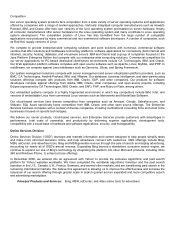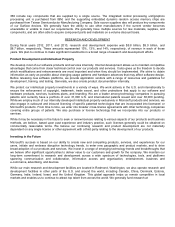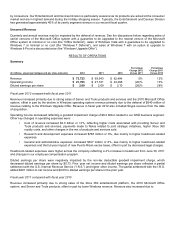Microsoft 2012 Annual Report Download - page 21
Download and view the complete annual report
Please find page 21 of the 2012 Microsoft annual report below. You can navigate through the pages in the report by either clicking on the pages listed below, or by using the keyword search tool below to find specific information within the annual report.
the $254 million Office Deferral in fiscal year 2010 and the subsequent recognition of the Office Deferral during fiscal year
2011. Changes in foreign currency exchange rates had an insignificant impact on revenue.
Operating income increased reflecting the change in revenue, offset in part by higher operating expenses. Key changes in
operating expenses were:
• Cost of revenue increased $3.2 billion or 26%, due to higher costs associated with our online offerings,
including traffic acquisition costs, and increased volumes of Xbox 360 consoles and Kinect for Xbox 360 sold.
• Sales and marketing expenses increased $726 million or 5%, primarily reflecting increased advertising and
marketing of the Xbox 360 platform, Windows Phone, and Windows and Windows Live, higher headcount-
related expenses and increased fees paid to third-party enterprise software advisors.
• Research and development expenses increased $329 million or 4%, due mainly to higher headcount-related
expenses.
• General and administrative expenses increased $159 million or 4%, due mainly to higher headcount-related
expenses and new Puerto Rican excise taxes, partially offset by prior year transition expenses associated with
the inception of the Yahoo! Commercial Agreement.
Diluted earnings per share increased, reflecting higher revenue, repurchases of common stock, and lower income tax
expense, offset in part by higher operating expenses.
SEGMENT PRODUCT REVENUE/OPERATING INCOME (LOSS)
The revenue and operating income (loss) amounts in this section are presented on a basis consistent with accounting
principles generally accepted in the U.S. (“U.S. GAAP”) and include certain reconciling items attributable to each of the
segments. Segment information appearing in Note 21 – Segment Information and Geographic Data of the Notes to
Financial Statements is presented on a basis consistent with our current internal management reporting. Certain
corporate-level activity has been excluded from segment operating results and is analyzed separately. We have recast
certain prior period amounts within this MD&A to conform to the way we internally managed and monitored segment
performance during the current fiscal year, including moving Forefront Protection for Office, an anti-malware solution, from
Server and Tools to the Microsoft Business Division.
Windows & Windows Live Division
(In millions, except percentages)
2012
2011
2010
Percentage
Change 2012
Versus 2011
Percentage
Change 2011
Versus 2010
Revenue
$
18,373
$
19,033
$
19,491
(3)%
(2)%
Operating income
$
11,460
$
12,211
$
12,895
(6)%
(5)%
Windows & Windows Live Division (“Windows Division”) develops and markets PC operating systems, related software
and online services, and PC hardware products. This collection of software, hardware, and services is designed to
simplify everyday tasks through seamless operations across the user’s hardware and software and efficient browsing
capabilities. Windows Division offerings consist of the Windows operating system, software and services through
Windows Live, and Microsoft PC hardware products.
Windows Division revenue is largely correlated to the PC market worldwide, as approximately 75% of total Windows
Division revenue comes from Windows operating system software purchased by original equipment manufacturers
(“OEMs”) which they pre-install on equipment they sell. The remaining approximately 25% of Windows Division revenue is
generated by commercial and retail sales of Windows and PC hardware products and online advertising from Windows
Live.
























